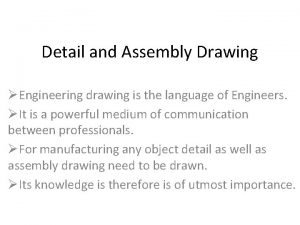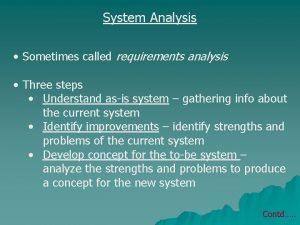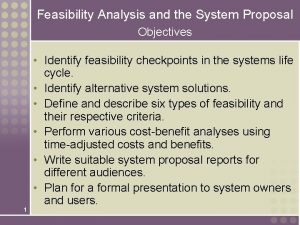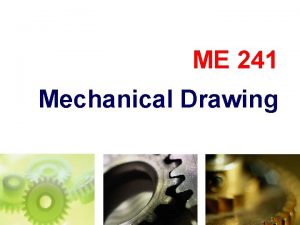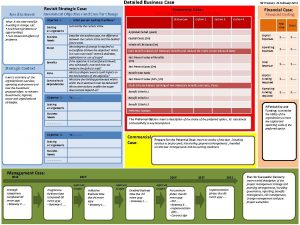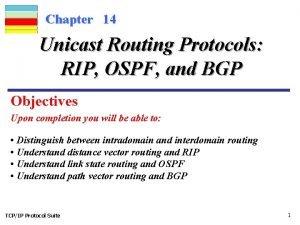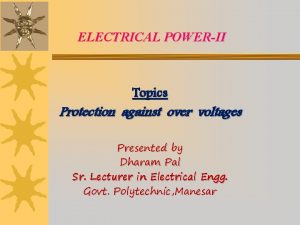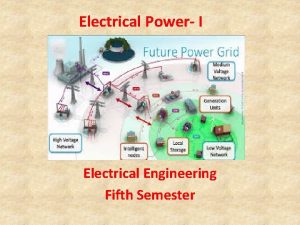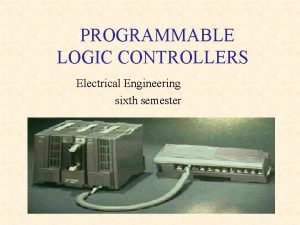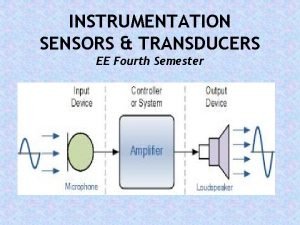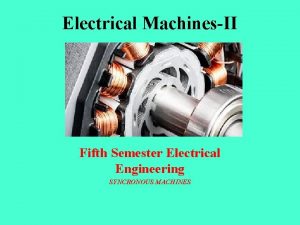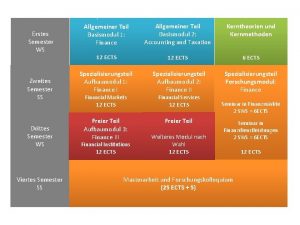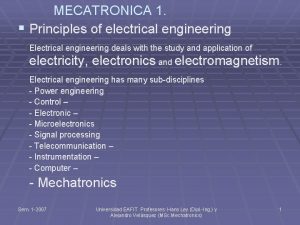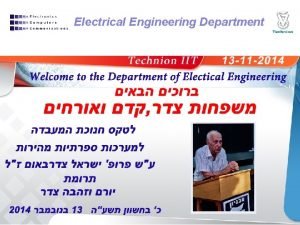ELECTRICAL POWERII Electrical engineering sixth semester Detailed Contents






















- Slides: 22

ELECTRICAL POWER-II Electrical engineering sixth semester

Detailed Contents • • Power-system protection Faults Types of Faults Switchgear Circuit Breaker Types of Circuit Breaker Fuse Classification of Fuses

Power-system protection • Power-system protection is a branch of electrical power engineering that deals with the protection of electrical power systems from faults through the isolation of faulted parts from the rest of the electrical network. • The objective of a protection scheme is to keep the power system stable by isolating only the components that are under fault • Protection systems usually comprise five components: • Current and voltage transformers to step down the high voltages and currents of the electrical power system to convenient levels for the relays to deal with • Protective relays to sense the fault and initiate a trip, or disconnection, order; • Circuit breakers to open/close the system based on relay and autorecloser commands; • Batteries to provide power in case of power disconnection in the system. • Communication channels to allow analysis of current and voltage at remote terminals of a line and to allow remote tripping of equipment.

Faults • A power system operates under balanced conditions. When the system becomes unbalanced due to the failures of insulation at any point or due to the contact of live wires, a short–circuit is said to occur • Faults may occur in the power system due to the number of reasons like natural disturbances (lightning, high-speed winds, earthquakes), insulation breakdown, falling of a tree, bird shorting, etc.

Types of Faults • Symmetrical faults ü line to ground (L-L-L-G) ü line to line (L-L-L) • Unsymmetrical faults ü line to ground (L-G), ü line to line (L-L) and ü double line to ground (LL-G) faults.

Symmetrical faults • These are very severe faults and occur infrequently in the power systems. These are also called as balanced faults and are of two types namely line to ground (L-L-L-G) and line to line (L-L-L). • Only 2 -5 percent of system faults are symmetrical faults.

Unsymmetrical faults • These are very common and less severe than symmetrical faults. There are mainly three types namely line to ground (LG), line to line (L-L) and double line to ground (LL-G) faults. • Line to ground fault (L-G) is most common fault and 65 -70 percent of faults are of this type. • 15 to 20 percent of faults are double line to ground

Causes of Electrical Faults • • Weather conditions Equipment failures Human errors Smoke of fires

Effects of electrical faults • • • Over current flow Danger to operating personnel Loss of equipment Disturbs interconnected active circuits Electrical fires

Fault limiting devices • • Fuse Circuit breaker Relay Lighting power protection devices

Switchgear One of the basic functions of switchgear is protection, which is interruption of shortcircuit and overload fault currents while maintaining service to unaffected circuits A switchgear has two types of components: • Power conducting components, such as switches, circuit breakers, fuses, and lightning arrestors, that conduct or interrupt the flow of electrical power • Control components as control panels, current transformers, potential transformers, protective relays, and associated circuitry, that monitor, control, and protect the power conducting components

Difference Between Isolator and Circuit Breaker BASIS ISOLATOR CIRCUIT BREAKER Type of device Isolator is an off load device Circuit Breaker is an On load device. Operation It is operated manually. It is operated Automatically. Action of device It is a Mechanical device which acts as a switch. It is an Electronic device made by using MOSFET or BJT. Function Isolator cut out a portion of a The Circuit breaker is a substation when a fault device such as ACB or MCB, occurred. The other devices which trips the entire system operate without any if there is any fault. interruption. Withstand Capability They have the low withstand They have the high withstand capacity as compared to capability at the on load Circuit Breaker. condition.

Circuit Breaker it is a switching device which can be operated manually and automatically for controlling and protection of electrical power system • The circuit breaker mainly consists of fixed contacts and moving contacts. In normal "ON" condition of circuit breaker, these two contacts are physically connected to each other due to applied mechanical pressure on the moving contacts. There is an arrangement stored potential energy in the operating mechanism of circuit breaker which is released if switching signal is given to the breaker • All circuit breaker have operating coils (tripping coils and close coil)

Types of Circuit Breaker • According to their arc quenching media the circuit breaker can be divided as- oil circuit breaker, Air circuit breaker, SF 6 circuit breaker. • According to their services the circuit breaker can be divided as- Outdoor circuit breaker, Indoor breaker. • According to the operating mechanism of circuit breaker they can be divided as- Spring operated circuit breaker, Pneumatic circuit breaker, Hydrolic circuit breaker. • According to the voltage level of installation types of circuit breaker are referred as- High voltage circuit breaker, Medium voltage circuit breaker, Low voltage circuit breaker.

Oil Circuit Breaker • Oil circuit breaker is such type of circuit breaker which used oil as a dielectric or insulating medium for arc extinction. In oil circuit breaker the contacts of the breaker are made to separate within an insulating oil • Oil circuit breaker is divided into - Bulk oil circuit breaker, low oil circuit breaker.

Sulphur Hexafluoride (SF 6) Circuit Breaker • A circuit breaker in which SF 6 under pressure gas is used to extinguish the arc is called SF 6 circuit breaker. SF 6 (sulphur hexafluoride) gas has excellent dielectric, arc quenching, chemical and other physical properties which have proved its superiority over other arc quenching mediums such as oil or air.

MCCB-Molded Case Circuit Breaker • The MCCB is used to control electric energy in distribution n/k and is having short circuit and overload protection. This circuit Breaker is an electromechanical device which guards a circuit from short circuit and over current. They offer short circuit and over current protection for circuits ranges from 63 Amps 3000 Amps.

ELCB -Earth Leakage Circuit Breaker • The ELCB is used to protect the circuit from the electrical leakage. When someone gets an electric shock, then this circuit breaker cuts off the power at the time of 0. 1 secs for protecting the personal safety and avoiding the gear from the circuit against short circuit and overload.

Fuse • Fuses are used for the prevention of home appliances from the short circuit and damage by overload or high current etc. • The fuses work on the principle of the heating effect of the current.

Characteristics of Fuses • Current Rating: The continuously conducting maximum amount of current holds the fuse without melting it is termed as current ratings. Current(Cin)=75%Current (rating) • Voltage Rating: In this characteristic, the voltage connected in series with fuse does not increase voltage rating V (fuse) >V(open ckt) • I 2 t Rating: It measures the heat energy(energy due to current flow) of fuse & it is generated when fuse has blown. • Interrupting or Breaking Capacity: It is the maximum rating of current without harm interrupt by the fuse is known as breaking or interrupting capacity of the fuse. Breaking capacity > maximum rated voltage • Temperature: In this, the operating temperature will be higher, therefore the current rating will be lesser, so the fuse melts

Classification of Fuses

THANKS
 The sixth sheik's sixth sheep's sick
The sixth sheik's sixth sheep's sick The sixth sick sheik's sixth sheep's sick lyrics
The sixth sick sheik's sixth sheep's sick lyrics Cross halving joint
Cross halving joint Detailed design in software engineering
Detailed design in software engineering Engineering notebook table of contents
Engineering notebook table of contents Define use case
Define use case Detailed analysis sometimes is called
Detailed analysis sometimes is called Objectives of skimming and scanning
Objectives of skimming and scanning Production planning and detailed scheduling
Production planning and detailed scheduling Detailed lesson plan in hairdressing
Detailed lesson plan in hairdressing Feasibility analysis matrix
Feasibility analysis matrix The filling station poem
The filling station poem Antenna effect in vlsi
Antenna effect in vlsi Cocomo 81 model
Cocomo 81 model Detailed lesson plan about problem solving
Detailed lesson plan about problem solving Me 241
Me 241 Short summary of heart of darkness by joseph conrad
Short summary of heart of darkness by joseph conrad Function oriented design in software engineering
Function oriented design in software engineering Detailed business case
Detailed business case A project size of 200 kloc is to be developed
A project size of 200 kloc is to be developed Write a detailed note on unicast routing protocols
Write a detailed note on unicast routing protocols What is detail drawing
What is detail drawing Jis z 8311
Jis z 8311


